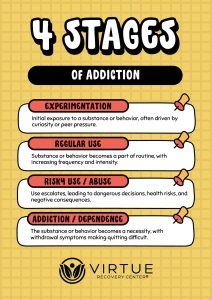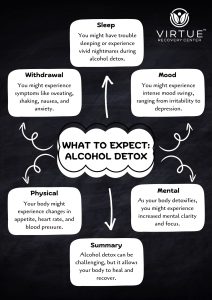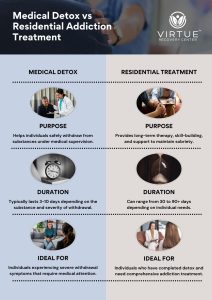Key Takeaways:
- Up to 25% of people with eating disorders are men, though they are less likely to seek treatment compared to women.
- Men often face stigma, leading to more severe cases before seeking help for eating disorders.
- Common eating disorders in men include binge eating disorder, anorexia nervosa, and bulimia nervosa.
- Virtue Recovery Las Vegas provides comprehensive treatment options for men struggling with eating disorders.
Introduction
Eating disorders are often perceived as issues that primarily affect women, but this stereotype overlooks the reality that many men also suffer from these severe conditions. Despite representing up to 25% of individuals with eating disorders, men are significantly less likely to be diagnosed or treated.
This lack of recognition often leads to more severe cases by the time men seek help. In this article, we’ll explore the prevalence of eating disorders in men, common symptoms, and the importance of timely treatment for recovery.
The Prevalence of Eating Disorders in Men
Eating disorders in men are more common than many people realize. Statistics show that men make up about 25% of those who struggle with these disorders, yet they are often undiagnosed. Compared to women, men are 1.5 times less likely to receive treatment.
One of the reasons for this disparity is the misconception that eating disorders are primarily “women’s problems.” This misconception creates a barrier, making it harder for men to recognize their symptoms or feel comfortable seeking help.
For men who do recognize that they need help, stigma and prejudice can make it challenging to receive the appropriate care. Studies show that healthcare professionals tend to minimize the symptoms of eating disorders in men, which only contributes to the severity of their condition by the time they finally seek treatment.
Common Eating Disorders in Men
While eating disorders are typically associated with women, the types of disorders that men experience are often the same. Here are the most common types of eating disorders in men:
Binge Eating Disorder
Binge eating disorder is the most prevalent eating disorder among men. It involves frequent episodes of consuming large quantities of food in a short period. Men may eat rapidly, even when not hungry, and feel guilt or shame afterward.
Anorexia Nervosa
Anorexia nervosa is characterized by extreme calorie restriction, intense fear of gaining weight, and a distorted body image. While this condition is more often associated with women, men also develop anorexia nervosa, though they may focus on achieving a muscular, lean physique rather than simply losing weight.
Bulimia Nervosa
Bulimia nervosa involves cycles of binge eating followed by compensatory behaviors, such as vomiting, excessive exercise, or the use of laxatives. Men who experience bulimia may feel trapped in a cycle of trying to control their body image while engaging in unhealthy eating patterns.
Signs and Symptoms of Eating Disorders in Men
Recognizing the signs of eating disorders in men can be challenging due to the cultural stigma and gender stereotypes associated with these conditions. Here are some of the most common symptoms:
- Extreme Concern with Body Image: Men may obsess over weight, muscle tone, and physical appearance.
- Disordered Eating Behaviors: Restricting food, binge eating, or purging behaviors may indicate an eating disorder.
- Excessive Exercise: Over-exercising to control body image or weight can indicate disordered eating.
- Social Withdrawal: Men with eating disorders may avoid social activities, particularly those involving food.
- Mood Changes: Anxiety, depression, or irritability often accompany eating disorders.
Due to the tendency for men to downplay these symptoms, they are less likely to seek help early on. In many cases, men’s eating disorder symptoms become severe before they are recognized or treated.
Why Men Face Barriers to Treatment
Men with eating disorders encounter unique challenges in getting the help they need. These challenges stem from societal expectations, stereotypes, and healthcare bias. Here are some reasons men face barriers to treatment:
- Stigma: Men may avoid seeking treatment due to the perception that eating disorders are “women’s issues.”
- Delayed Recognition: Men are often slower to recognize their symptoms as problematic, leading to more severe cases by the time they seek help.
- Minimized Symptoms: Research shows that healthcare providers sometimes reduce eating disorder symptoms in men, making it harder for them to receive proper treatment.
The Importance of Early Intervention and Treatment
Early intervention can make a significant difference in the recovery process for men with eating disorders. Delaying treatment only exacerbates the physical and mental health consequences of these disorders, leading to potential long-term health risks.
Seeking help from a trusted provider like Virtue Recovery Las Vegas is crucial for successful recovery. Virtue Recovery treatment programs are designed to provide comprehensive care, addressing the physical and psychological aspects of eating disorders. Treatment may include medical intervention, nutritional guidance, therapy, and long-term support.
Conclusion
Eating disorders in men are a serious but often overlooked issue. Early recognition and treatment are essential for preventing severe health complications and promoting long-term recovery. If you or a loved one is struggling with an eating disorder, it’s essential to seek professional help.
At Virtue Recovery Las Vegas, we provide specialized care tailored to meet the unique needs of men suffering from eating disorders. Our team is dedicated to helping you on your path to recovery. Call 866-520-2861 today to begin your journey toward health and wellness.
FAQs About Eating Disorders in Men and Boys
What are the most common eating disorders in men?
The most common eating disorders in men include binge eating disorder, anorexia nervosa, and bulimia nervosa.
Why are men less likely to seek treatment for eating disorders?
Men face stigma and misconceptions, often seeing eating disorders as “women’s problems.” This can delay their recognition of symptoms and make them less likely to seek help.
How do healthcare professionals typically view eating disorders in men?
Unfortunately, healthcare providers sometimes minimize or overlook the symptoms of eating disorders in men, contributing to more severe cases by the time men seek help.
Can eating disorders in men be treated?
Yes, eating disorders in men can be effectively treated through comprehensive care, including therapy, nutritional support, and medical intervention.
How prevalent are eating disorders in men?
Up to 25% of individuals with eating disorders are men, but they are less likely to be diagnosed or treated compared to women.
What are the different types of eating disorders in males?
Common types of eating disorders in males include anorexia nervosa, bulimia nervosa, binge eating disorder, and unspecified feeding or eating disorder. Males with eating disorders may also experience body dysmorphic disorder and engage in restrictive eating or other disordered eating behaviors.
What are some common causes among men and boys that develop an eating disorder?
Causes of eating disorders in men and boys often include body image issues, societal pressure to achieve a certain physique, and experiences with body dysmorphic disorder. Trauma, stress, and low self-esteem also contribute to the development of disordered eating behaviors in males.
What group is more at risk of developing an eating disorder?
Young boys and men involved in sports or activities that emphasize body appearance, such as bodybuilding or wrestling, are at higher risk for eating disorders. Those with a family history of eating disorders or who experience mental health conditions like anxiety are also more vulnerable.
What does eating disorder treatment look like among male patients?
Eating disorder treatment for males involves a combination of therapy, medical monitoring, and nutritional counseling. Addressing eating disorders in men and boys focuses on changing eating disorder behaviors, improving body image, and tackling underlying issues like body dysmorphic disorder and binge eating episodes.
Are Eating Disorders in Men and The LGBTQIA+ Community Linked?
Eating disorders in men and the LGBTQIA+ community can be linked due to societal pressure and discrimination. Implementing strategies for addressing eating disorders in lgbtqia++ individuals involves creating a supportive and inclusive environment, offering specialized counseling and treatment, and promoting body positivity and self-acceptance.
Resources
https://nedc.com.au/eating-disorders/eating-disorders-explained/eating-disorders-in-males
https://www.ncbi.nlm.nih.gov/pmc/articles/PMC3479631/
https://www.medicalnewstoday.com/articles/eating-disorders-in-men













